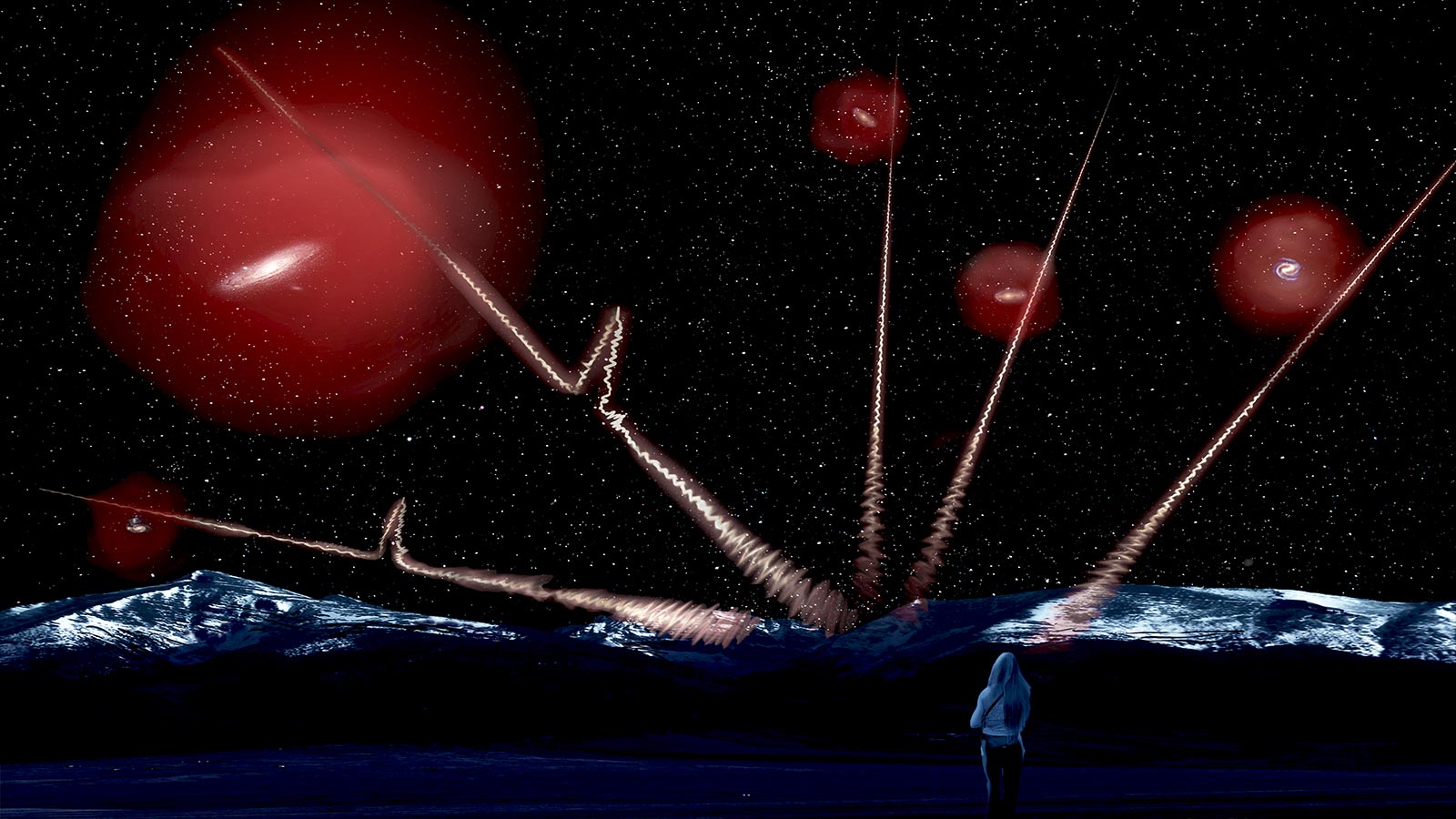

يُظهر مفهوم هذا الفنان انفجارات راديو سريعة بعيدة تخترق الهالات الغازية حول المجرات في الكون المحلي. تم تصوير الدفقات الراديوية وهي تسافر من الكون البعيد ، عبر هالات المجرة ، وأخيراً تصل إلى التلسكوبات على الأرض. النتوءات التي شوهدت في اثنين من الخطوط تمثل الاندفاع الراديوي أثناء انتقالها نحو الأرض. الائتمان: بإذن من تشارلز كارتر
يمكن استخدام النبضات الراديوية الكونية القوية التي تنشأ في أعماق الكون لدراسة البرك الخفية من الغاز المتواجد في المجرات القريبة ، وفقًا لدراسة جديدة نُشرت الشهر الماضي في المجلة. علم الفلك الطبيعي.
ما يسمى انفجارات راديو سريعة، أو FRBs ، هي نبضات من موجات الراديو التي عادة ما تنشأ من ملايين إلى مليارات السنين الضوئية. (موجات الراديو هي إشعاع كهرومغناطيسي مثل الضوء الذي نراه بأعيننا ولكن لها أطوال موجية أطول وترددات أقل). تم اكتشاف أول FRB في عام 2007 ، ومنذ ذلك الحين ، تم اكتشاف مئات أخرى. في عام 2020 ، أداة STARE2 التابعة لمعهد كاليفورنيا للتكنولوجيا (مسح للانبعاثات الراديوية الفلكية العابرة 2) و CHIME الكندية (تجربة رسم خرائط كثافة الهيدروجين الكندية) اكتشف FRB هائلًا انطلق في مجرتنا درب التبانة. ساعدت هذه النتائج السابقة في تأكيد النظرية القائلة بأن الأحداث النشطة على الأرجح تنشأ من النجوم الممغنطة الميتة والتي تسمى النجوم المغناطيسية.
مع دخول المزيد والمزيد من FRBs ، يبحث العلماء الآن في كيفية استخدامها لدراسة الغاز الموجود بيننا وبين الانفجارات. على وجه التحديد ، يرغبون في استخدام FRBs لسبر هالات الغاز المنتشر التي تحيط بالمجرات. مع انتقال النبضات الراديوية نحو الأرض ، من المتوقع أن يعمل الغاز الذي يغلف المجرات على إبطاء الموجات وتشتيت ترددات الراديو. في الدراسة الجديدة ، نظر فريق البحث في عينة من 474 FRBs بعيدًا تم اكتشافها بواسطة CHIME ، والتي اكتشفت معظم FRBs حتى الآن. لقد أظهروا أن المجموعة الفرعية المكونة من عشرين FRBs التي مرت عبر هالات المجرة قد تباطأت بالفعل أكثر من FRBs غير المتقاطعة.
“تُظهر دراستنا أن FRBs يمكن أن تكون بمثابة أسياخ لجميع المواد بين التلسكوبات الراديوية ومصدر موجات الراديو” ، كما يقول المؤلف الرئيسي ليام كونور ، باحث تولمان ما بعد الدكتوراة في علم الفلك ، والذي يعمل مع أستاذ مساعد في علم الفلك و مؤلف مشارك في الدراسة ، فيكرام رافي.
“لقد استخدمنا دفقات راديو سريعة لتسليط الضوء من خلال هالات المجرات بالقرب من[{” attribute=””>Milky Way and measure their hidden material,” Connor says.
The study also reports finding more matter around the galaxies than expected. Specifically, about twice as much gas was found as theoretical models predicted.
All galaxies are surrounded and fed by massive pools of gas out of which they were born. However, the gas is very thin and hard to detect. “These gaseous reservoirs are enormous. If the human eye could see the spherical halo that surrounds the nearby Andromeda galaxy, the halo would appear one thousand times larger than the moon in area,” Connor says.
Researchers have developed different techniques to study these hidden halos. For example, Caltech professor of physics Christopher Martin and his team developed an instrument at the W. M. Keck Observatory called the Keck Cosmic Webb Imager (KCWI) that can probe the filaments of gas that stream into galaxies from the halos.
This new FRB method allows astronomers to measure the total amount of material in the halos. This can be used to help piece together a picture of how galaxies grow and evolve over cosmic time.
“This is just the start,” says Ravi. “As we discover more FRBs, our techniques can be applied to study individual halos of different sizes and in different environments, addressing the unsolved problem of how matter is distributed in the universe.”
In the future, the FRB discoveries are expected to continue streaming in. Caltech’s 110-dish Deep Synoptic Array, or DSA-110, has already detected several FRBs and identified their host galaxies. Funded by the National Science Foundation (NSF), this project is located at Caltech’s Owen Valley Radio Observatory near Bishop, California. In the coming years, Caltech researchers have plans to build an even bigger array, the DSA-2000, which will include 2,000 dishes and be the most powerful radio observatory ever built. The DSA-2000, currently being designed with funding from Schmidt Futures and the NSF, will detect and identify the source of thousands of FRBs per year.
Reference: “The observed impact of galaxy halo gas on fast radio bursts” by Liam Connor and Vikram Ravi, 4 July 2022, Nature Astronomy.
DOI: 10.1038/s41550-022-01719-7

“هواة الإنترنت المتواضعين بشكل يثير الغضب. مثيري الشغب فخور. عاشق الويب. رجل أعمال. محامي الموسيقى الحائز على جوائز.”
